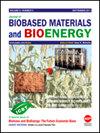The Effects of Calcium and Magnesium Deficiency on the Growth, Physiology, and Nutrient Uptake Characteristics of Walnut Trees
IF 0.5
4区 医学
引用次数: 0
Abstract
This study explored the response characteristics and adaptation mechanisms of walnut saplings under calcium and magnesium deficiency. Using walnut saplings as the research subjects, and three treatment groups were established for pot experiments: no deficiency (control, CK), calcium deficiency (–Ca), and magnesium deficiency (–Mg). The development, physiological attributes, and mineral composition of walnut seedlings were assessed, with an analysis focusing on how deficiencies in calcium and magnesium impact these elements. Compared to the findings in the CK group, walnut plant height, ground diameter, leaf area, root length, root area, number of root tips, and biomass were significantly decreased in the –Ca and –Mg groups. However, the proportions of the root surface area attributable to level I and II roots were significantly increased in the –Ca and –Mg groups, whereas that attributable to level V roots was significantly decreased. The root-to-shoot ratio was significantly increased in both groups. Peroxidase (POD), proline (Pro), and malondialdehyde (MDA) levels in walnuts significantly increased under calcium deficiency ( p <0.05), Moreover, when there is a deficiency in magnesium, there is a notable escalation in the activities of SOD, POD, and catalase, as well as a marked rise in the levels of Pro, MDA, and soluble sugars. Calcium and magnesium deficiency significantly altered mineral content of walnuts. Calcium deficiency inhibited the absorption of N, Ca, Fe, Zn, Cu, and Mn, but promoted that of P, K, and Mg. Magnesium deficiency inhibited the absorption of N, P, K, Mg, and Fe, whereas it has no effect on other minerals. Long-term calcium and magnesium deficiency significantly affected the growth of walnut saplings, with magnesium deficiency having strong effects. However, saplings adjusted to mineral deficiency by enhancing the absorption capacity of their roots. Simultaneously, They stimulated the antioxidant protection mechanisms, modulating the activity of enzymes that combat oxidation, and altering the levels of free Pro and soluble sugars within cells to eliminate free radicals generated due to stress. This, in turn, alleviates the harm caused by lipid peroxidation and bolsters resistance to adverse stress.钙镁缺乏对核桃树生长、生理及养分吸收特性的影响
本研究探讨了钙镁缺乏对核桃幼树的响应特性及适应机制。以核桃树苗为研究对象,设无亏(对照,CK)、缺钙(-Ca)、缺镁(-Mg) 3个处理组进行盆栽试验。评估了核桃幼苗的发育、生理特性和矿物质组成,重点分析了钙和镁缺乏对这些元素的影响。与CK组相比,-Ca和-Mg组核桃株高、地径、叶面积、根长、根面积、根尖数和生物量均显著降低。但在-Ca和-Mg处理下,1级和2级根系占根表面积的比例显著增加,而V级根系占根表面积的比例显著降低。两组根冠比均显著升高。缺钙条件下核桃过氧化物酶(POD)、脯氨酸(Pro)和丙二醛(MDA)水平显著升高(p <0.05),缺镁条件下核桃SOD、POD和过氧化氢酶活性显著升高,Pro、MDA和可溶性糖水平显著升高。钙和镁的缺乏显著改变了核桃的矿物质含量。缺钙抑制了氮、钙、铁、锌、铜、锰的吸收,促进了磷、钾、镁的吸收。缺镁抑制了氮、磷、钾、镁和铁的吸收,而对其他矿物质的吸收无影响。长期缺钙、缺镁对核桃幼树生长影响显著,其中缺镁影响较大。然而,树苗通过增强其根的吸收能力来适应矿物质的缺乏。同时,它们刺激抗氧化保护机制,调节抗氧化酶的活性,改变细胞内游离Pro和可溶性糖的水平,以消除因压力而产生的自由基。这反过来又减轻了脂质过氧化造成的伤害,增强了对不利压力的抵抗力。
本文章由计算机程序翻译,如有差异,请以英文原文为准。
求助全文
约1分钟内获得全文
求助全文

 求助内容:
求助内容: 应助结果提醒方式:
应助结果提醒方式:


